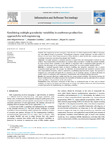Combining Multiple Granularity Variability in a Software Product Line Approach for Web Engineering

Use this link to cite
http://hdl.handle.net/2183/31170Collections
- Investigación (FIC) [1685]
Metadata
Show full item recordTitle
Combining Multiple Granularity Variability in a Software Product Line Approach for Web EngineeringDate
2022Citation
HORCAS, Jose-Miguel, CORTIÑAS, Alejandro, FUENTES, Lidia and LUACES, Miguel R., 2022. Combining multiple granularity variability in a software product line approach for web engineering. Information and Software Technology. 2022. Vol. 148, p. 106910. DOI https://doi.org/10.1016/j.infsof.2022.106910
Abstract
[Abstract] Context: Web engineering involves managing a high diversity of artifacts implemented in different languages and with different levels of granularity. Technological companies usually implement variable artifacts of Software Product Lines (SPLs) using annotations, being reluctant to adopt hybrid, often complex, approaches combining composition and annotations despite their benefits. Objective: This paper proposes a combined approach to support fine and coarse-grained variability for web artifacts. The proposal allows web developers to continue using annotations to handle fine-grained variability for those artifacts whose variability is very difficult to implement with a composition-based approach, but obtaining the advantages of the composition-based approach for the coarse-grained variable artifacts. Methods: A combined approach based on feature modeling that integrates annotations into a generic composition-based approach. We propose the definition of compositional and annotative variation points with custom-defined semantics, which is resolved by a scaffolding-based derivation engine. The approach is evaluated on a real-world web-based SPL by applying a set of variability metrics, as well as discussing its quality criteria in comparison with annotations, compositional, and combined existing approaches. Results: Our approach effectively handles both fine and coarse-grained variability. The mapping between the feature model and the web artifacts promotes the traceability of the features and the uniformity of the variation points regardless of the granularity of the web artifacts. Conclusions: Using well-known techniques of SPLs from an architectural point of view, such as feature modeling, can improve the design and maintenance of variable web artifacts without the need of introducing complex approaches for implementing the underlying variability.
Keywords
Annotations
Composition
Feature models
SPL
Variability
Web engineering
Composition
Feature models
SPL
Variability
Web engineering
Editor version
Rights
Atribución 4.0 Internacional






